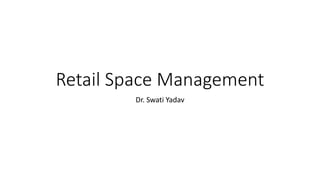
Retail space management sy
- 1. Retail Space Management Dr. Swati Yadav
- 2. RETAIL CONCEPTS & PRACTICES • UNIT 1: Introduction to Retail Management, the concept of Retailing, Economic significance of Retailing, Nature, Scope, Functions of Retailers, Retailing scenario in India. • UNIT 2: Indian and Global Retail Environment, the evolution of retail in India, the rise of the retailer, challenges and changes impacting retail development in India. • UNIT 3: Retail Formats, Retail Models and theories of retail development, the future of retailing • UNIT 4: Organization Designs and Structure in Retail, Human Resource Management in Retail. • UNIT 5: Space Management, Factors Affecting Store Location, Retail Trade Area Analysis. Layout and Design.
- 3. Introduction • Space management is one of the crucial challenges faced by today’s retail managers. A well-organized shopping place increases productivity of inventory, enhances customers’ shopping experience, reduces operating costs, and increases financial performance of the retail store. It also elevates the chances of customer loyalty.
- 4. What is Space Management? • It is the process of managing the floor space adequately to facilitate the customers and to increase the sale. Since store space is a limited resource, it needs to be used wisely. • Space management is very crucial in retail as the sales volume and gross profitability depends on the amount of space used to generate those sales.
- 5. Optimum Space Use • While allocating the space to various products, the managers need to consider the following points: Product Category: Profit builders: High profit margins-low sales products. Allocate quality space rather than quantity. Star performers: Products exceeding sales and profit margins. Allocate large amount of quality space. Space wasters: Low sales-low profit margins products. Put them at the top or bottom of shelves. Traffic builders: High sales-low profit margins products. These products need to be displayed close to impulse products. Size, shape, and weight of the product. Product adjacencies – It means which products can coexist on display? Product life on the shelf.
- 6. Retail Floor Space • Here are the steps to take into consideration for using floor space effectively: • Measure the total area of space available. • Divide this area into selling and non-selling areas such as aisle, storage, promotional displays, customer support cell, (trial rooms in case of clothing retail) and billing counters. • Create a Planogram, a pictorial diagram that depicts how and where to place specific retail products on shelves or displays in order to increase customer purchases. • Allocate the selling space to each product category. Determine the amount of space for a particular category by considering historical and forecasted sales data. Determine the space for billing counter by referring historical customer volume data. In case of clothing retail, allocate a separate space for trial rooms that is near the product display but away from the billing area.
- 7. • Determine the location of the product categories within the space. This helps the customers to locate the required product easily. • Decide product adjacencies logically. This facilitates multiple product purchase. For example, pasta sauces and spices are kept near raw pasta packets. • Make use of irregular shaped corner space wisely. Some products such as domestic cleaning devices or garden furniture can stand in a corner. • Allocate space for promotional displays and schemes facing towards road to notify and attract the customers. Use glass walls or doors wisely for promotion.
- 8. Store Layout and Design • Customer buying behavior is an important point of consideration while designing store layout. • The objectives of store layout and design are: • It should attract customers. • It should help the customers to locate the products effortlessly. • It should help the customers spend longer time in the store. • It should motivate customers to make unplanned, impulsive purchases. • It should influence the customers’ buying behavior.
- 9. Store Layout Formats • The retail store layouts are designed in way to use the space efficiently. There are broadly three popular layouts for retail stores: Grid Layout: Mainly used in grocery stores.
- 10. • Loop Layout: Used in malls and departmental stores.
- 11. • Free Layout: Followed mainly in luxury retail or fashion stores.
- 12. Store Design • Both internal and external factors matter when it comes to store design. Interior Design • The store interior is the area where customers actually look for products and make purchases. It directly contributes to influence customer decision making. In includes the following: • Clear and adequate walking space, separate from product display area. • Free standing displays: Fixtures, rotary displays, or mannequins installed to attract customers’ attention and bring them to the store. • End caps: These displays at the end of the aisles can be used to display promotional offers. • Windows and doors can provide visual messages about merchandise on sale.
- 13. • Proper lighting at the product display. For example, jewelry retail needs more acute lighting. • Relevant signage with readable typefaces and limited text for product categories, for promotional schemes, and at Point of Sale (POS) that guides customers’ decision-making process. It can also include hanging signage for enhancing visibility. • Sitting area for a few differently abled people or senior citizens.
- 14. Exterior Design • This area outside the store is as much important as the interior of the store. It communicates with the customer on who the retailer is and what it stands for. The exterior includes: • Name of the store, which tells the world that it exists. It can be a plain painted board or as fancy as an aesthetically designed digital board of the outlet. • The store entrance: Standard or automatic, glass, wood, or metal? Width of the entrance. • The cleanliness of the area around the store. • The aesthetics used to draw the customers inside the store.